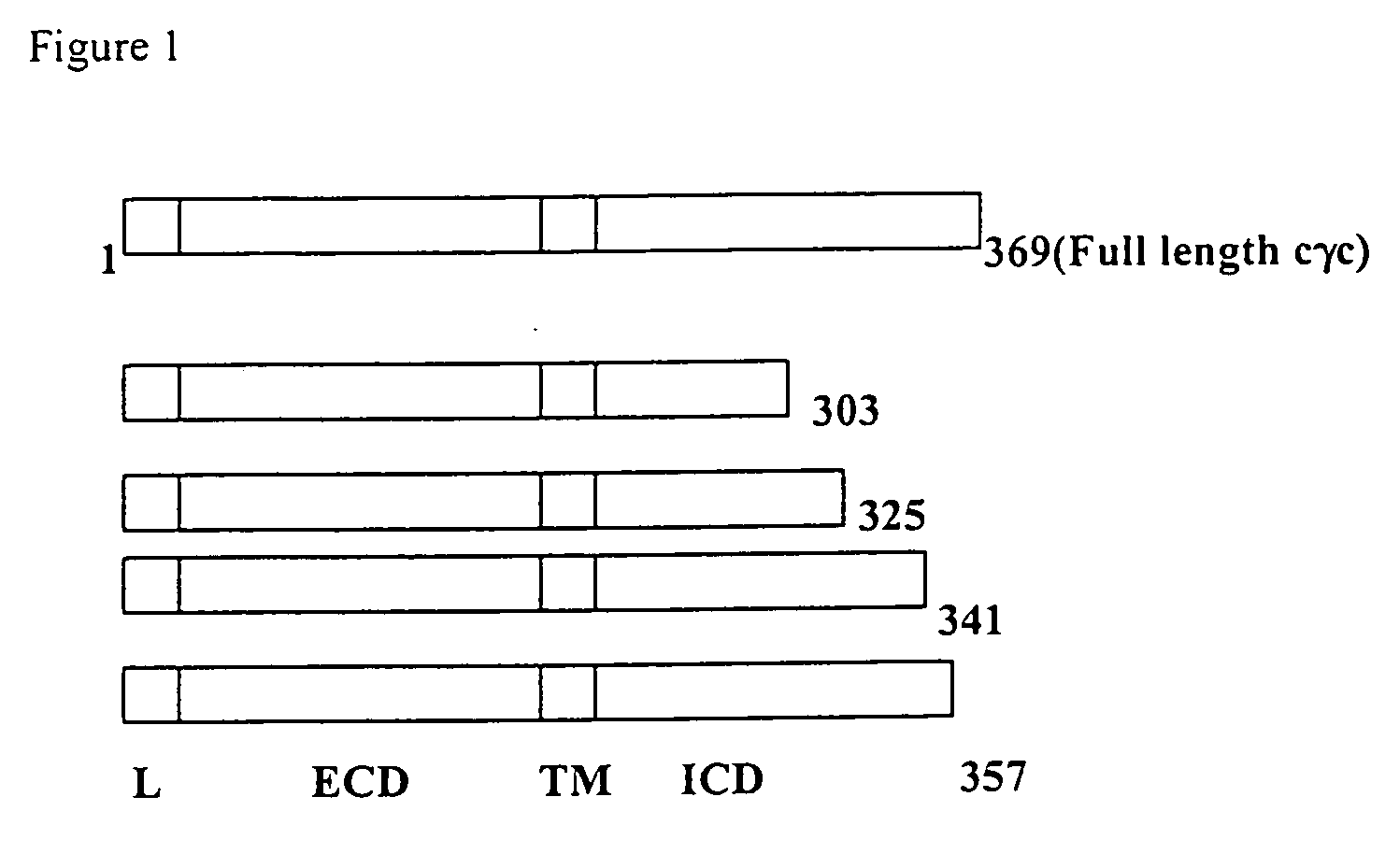Derivatives of the il-2 receptor gamma chain, their production and use
a technology of il-2 receptor and derivatives, applied in the field of common gamma chain of il-2 receptor, can solve the problems of limited information yet of the downstream mechanism of nik action, uncertainty as to the way by which nik triggers p100, and likewise rather
- Summary
- Abstract
- Description
- Claims
- Application Information
AI Technical Summary
Benefits of technology
Problems solved by technology
Method used
Image
Examples
example 1
Detection of Proteins Interacting with NIK by the Two-Hybrid System Method:
[0152] The two-hybrid system method in yeast, widely used for detecting in-vivo protein-protein interaction, has been used to screen a DNA expression library to find and identify proteins that interact with NIK (see details in Example 8). A human bone marrow library has been selected based on evidence indicating a pivotal role of NIK in the lymphoid system development and function.
[0153] The N-terminal region of NIK contains a negative regulatory domain (NRD), which interacts with the C-terminal region of NIK, thereby inhibiting the binding of NIK to its substrates (IKK alpha and p100). Interaction between the C- and N terminal region of NIK prevents binding of NIK to its substrates. The C-terminal domain of NIK was found to be responsible for the binding of NIK to several key regulatory proteins such as TRAF-2, IKK-1 and to P100, suggesting that this domain may bind additional proteins, which are importan...
example 2
Evaluation of IL-2 Gamma Chain—NIK Interactions in a Mammalian Environment:
[0156] The detection of a specific interaction between two different mammalian proteins in a two-hybrid system in yeast does not necessarily imply that there exists a corresponding interaction between the proteins in a native mammalian environment. Therefore, in order to verify NIK and cγc interaction in a mammalian environment, co-immunoprecipitation studies of NIK and cγc were carried out in lysates of 293-T cells overexpresing these proteins (for details see Example 9).
[0157] To overexpress NIK and cγc, 293-T cells were co-transfected with equal amounts of NIK and cγc expression plasmids (pcS3MTNIK, myc tag at its N-terminus and pcDNA3 cγc respectively, both plasmids having similar molecular weight). The overexpressed proteins were immunoprecipitated with antibodies specific for one of the proteins (e.g. NIK) and the presence of a coprecipitated protein (e.g. cγc) was detected by Western blots analysis....
example 3
Mapping the Region in cγc Responsible for Binding NIK:
[0163] To define the domain of cγc responsible for binding NIK, deletion mutants of cγc have been created and their binding to NIK analysed (FIG. 1).
[0164] The deletion mutants were created by sequentially introduction of stop codons in the cytoplasmic domain of cγc, in gaps of 10-20 amino acids. The DNA encoding the full-length cγc or its deletion mutants were introduced into the pGADT7 prey vector (Clontech) for testing their binding to NIK in the SFY526 heterologous yeast strain by the two hybrid assay. The SFY526 yeast strain is prototrophic for TRP and Leu. pGBKT plasmids (bait vector) have the Trp1 wild type gene and pGAD has the wild type Leu2 gene. Thus, only doubly transfected yeast will grow on selective Leu Trp media. Functional GAL4 will be restored in doubly transfected yeast when the chimeric proteins fused to GAL4 domains interact, bringing the activation domain and DNA binding domain of GAL4 to close proximity....
PUM
| Property | Measurement | Unit |
|---|---|---|
| concentrations | aaaaa | aaaaa |
| concentrations | aaaaa | aaaaa |
| concentrations | aaaaa | aaaaa |
Abstract
Description
Claims
Application Information
 Login to View More
Login to View More - R&D
- Intellectual Property
- Life Sciences
- Materials
- Tech Scout
- Unparalleled Data Quality
- Higher Quality Content
- 60% Fewer Hallucinations
Browse by: Latest US Patents, China's latest patents, Technical Efficacy Thesaurus, Application Domain, Technology Topic, Popular Technical Reports.
© 2025 PatSnap. All rights reserved.Legal|Privacy policy|Modern Slavery Act Transparency Statement|Sitemap|About US| Contact US: help@patsnap.com



